Kalaripayattu is one of the oldest surviving martial art forms, with roots that trace back over 3,000 years to the southern state of Kerala in India.
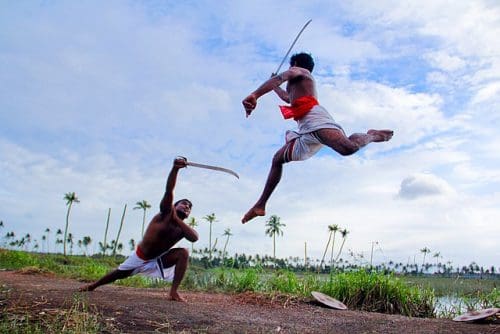
Often referred to as the “mother of all martial arts,” Kalaripayattu is deeply intertwined with Kerala‘s culture and traditions. It is a unique blend of physical prowess, discipline, combat techniques, and spiritual development.
Historical Background
The origins of Kalaripayattu are believed to have been established by Lord Parasurama, the sixth avatar of Lord Vishnu, according to Hindu mythology. The word “Kalari” means battlefield, and “Payattu” refers to fight or practice. So, Kalaripayattu can be translated as the “practice in the arts of the battlefield.”
Training and Techniques
- Physical Conditioning: Training begins with a rigorous regimen to attain peak physical fitness and flexibility. Exercises mimic the movements of various animals, giving rise to techniques such as the “elephant posture,” “cat posture,” and “snake posture.”
- Combat Techniques: Students learn unarmed combat before moving on to weaponry. The techniques involve strikes, kicks, grappling, and defensive methods.
- Weapons: Kalaripayattu incorporates various weapons into its training, including:
- Urumi: A long, flexible sword.
- Kathi: A knife.
- Kuntham: A spear.
- Otta: A curved wooden stick.
- Mace and shields.
- Marmashastram: This is the science of vital points. Knowledge of these points allows a Kalaripayattu practitioner to incapacitate or heal. They are the pressure points of the human body, and hitting them can have lethal effects.
Spiritual and Healing Aspects
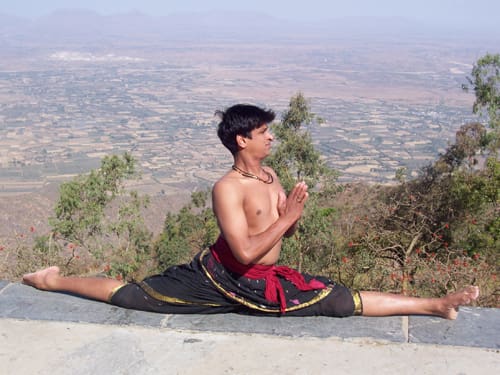
Image Credit: Travel&Heritage, CC BY-SA 3.0 via Wikimedia Commons
Apart from the physical training, Kalaripayattu also emphasizes spiritual development. Practitioners meditate and practice breathing techniques to strengthen their mental focus and discipline.
Moreover, Kalaripayattu is closely associated with the traditional Indian medical practice known as Ayurveda. Many Kalaripayattu practitioners are also trained in Ayurvedic treatments and massage therapies. The healing practices ensure that warriors can recover rapidly from injuries.
Cultural Impact
Kalaripayattu has influenced various dance forms in the state, most notably Kathakali and Theyyam, where artists use postures and movements inspired by martial art. Moreover, it’s not only the foundation for physical conditioning for dancers but also a source of choreographic techniques.
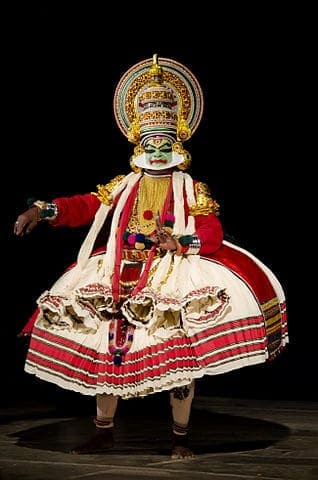
Image Credit: I, Prathyush Thomas via Wikimedia Commons
Modern-Day Relevance
Over the past few decades, there has been a resurgence of interest in Kalaripayattu. Schools have popped up across the world, and it’s been incorporated into various fitness programs. Film and theatre artists have trained in Kalaripayattu for physically demanding roles, and it has gained international recognition for its comprehensive approach to physical and mental wellness.
How is Kalaripayattu taught to beginners?
Teaching Kalaripayattu to beginners is a systematic process that involves a holistic approach encompassing physical training, mental conditioning, and spiritual discipline. The training, traditionally imparted in specially designed pits called ‘Kalari’, is structured to move from basic sequences to more advanced techniques as the student progresses.
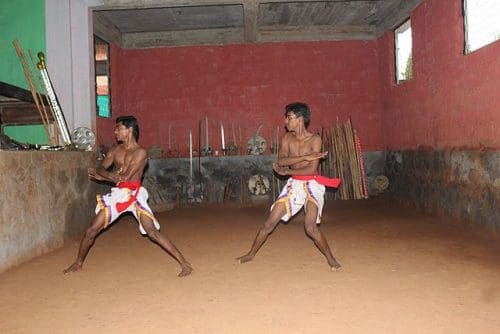
Image Credit: India1277, CC BY-SA 4.0 via Wikimedia Commons
Here’s an overview of how beginners are introduced to the world of Kalaripayattu:
Initiation Ritual Before starting the actual training, there’s often a ceremonial initiation ritual to pay respects to the deity of the Kalari, the earth, and the master or ‘Gurukkal’. This sets the tone for the discipline and reverence with which art should be approached.
Body Conditioning The initial stages focus on making the body agile, flexible, and strong. Beginners undergo:
- Meythari: Basic postures, leg swings, and body sequences that instil balance, coordination, and stamina. This phase might include exercises that imitate animal movements, such as the lion, elephant, cat, or snake, each focusing on different aspects of agility and strength.
- Physical Conditioning: Rigorous exercises, including stretches, jumps, and squats, which are designed to increase strength, stamina, and flexibility.
Basic Combat Techniques Once a certain level of physical fitness is achieved, students move on to basic combat techniques:
- Unarmed combat: This involves learning to use the body as a weapon, and mastering punches, kicks, locks, and grappling techniques.
- Basic sequences (vandus): Choreographed patterns of movement that combine defence and attack, teaching students to anticipate and counter an opponent’s moves.
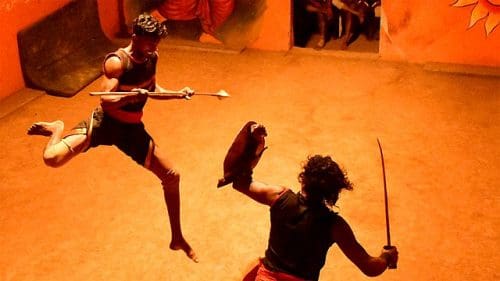
Introduction to Weapons Though beginners won’t start with advanced weaponry, they are often introduced to basic weapons like:
- Sticks (Kettukari): The most basic weapon, practising with sticks helps students understand distance, timing, and rhythm in combat.
- Breathing and Meditation From the beginning, the importance of breath control is emphasized. Proper breathing techniques are essential for executing moves with power and precision. Meditation is introduced to help students cultivate focus, calmness, and mental clarity.
- Cultural and Philosophical Context To understand Kalaripayattu deeply, students are also taught about its cultural significance, historical evolution, and the philosophical principles that underpin the art form.
- Respect and Discipline Throughout the training, a strong emphasis is placed on respect – respect for the Gurukkal (teacher), for fellow students, and for the space (Kalari). Discipline, dedication, and humility are considered as important as physical prowess.
In conclusion, for beginners, Kalaripayattu is not just about learning combat techniques; it’s an immersive experience that shapes the body, mind, and spirit. The initial stages lay the foundation upon which the more advanced practices are built. As they progress, students delve deeper into the complexities and nuances of this ancient martial art.
Female Kalaripayattu practitioners
Yes, there are many female practitioners. While historically, Kalaripayattu was predominantly practiced by men, the narrative has shifted over the past few decades. Today, women actively practice, perform, and even teach this ancient martial art form.
Notable Female Kalaripayattu Practitioners:
- Meenakshi Raghavan: Often hailed as the “Granny of Kalaripayattu”, Meenakshi Raghavan, also known as Meenakshi Amma, garnered international attention for her proficiency in the art. Even in her 70s, she showcased exceptional skills in demonstrations and competitions. She has also been an avid teacher, training many students, both male and female, at her school in Vadakara.
- Sreedevi Unni: A Kalaripayattu expert and Mohiniyattam dancer, Sreedevi Unni seamlessly blends the martial art form into her dance performances. She is a prominent figure who advocates for the integration of this martial art into classical dance training.
- Santhi V. Kavinkal: Santhi is another revered name. She has been practising since a very young age and now runs her own school, where she trains a new generation of enthusiasts.
- Lakshmi R. Menon: A researcher and practitioner, Lakshmi uses this marital art as a tool for empowerment. She conducts workshops for women, focusing on self-defence and personal development using the principles of Kalaripayattu.
Apart from these individuals, there are many women worldwide, including outside India, who have embraced Kalaripayattu for its holistic approach to fitness, self-defense, and personal growth. The martial art has been an empowering tool, providing a platform to break gender stereotypes and showcasing that strength and grace are attributes not bound by gender.
Kalaripayattu tournaments or competitions
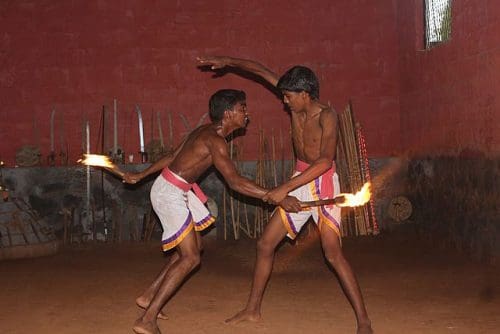
Yes, there are several tournaments and competitions, both at regional and national levels. These events offer practitioners a platform to showcase their skills, techniques, and expertise in this ancient martial art. While the art’s primary essence is spiritual growth, discipline, and self-defense, competitions add a modern dimension to its practice by promoting the martial art and keeping its traditions alive.
Features of Kalaripayattu Tournaments:
- Competitive Categories: These tournaments usually have various categories based on age, gender, and skill level. They may include separate competitions for Meythari (body sequences), combat sequences, and weapon demonstrations.
- Judging Criteria: Participants are judged on technique, flexibility, strength, speed, precision, and adherence to traditional forms. In weapon-based routines, expertise in handling the weapon, the fluidity of movement, and combat simulation are crucial.
- Demonstrations: Beyond competitive sparring, these tournaments often feature demonstrations where seasoned practitioners or Gurukkals exhibit advanced techniques, mesmerizing audiences with their mastery.
- Promotion of the Art: These events play a pivotal role in promoting the martial art, especially among the younger generation. By showcasing the martial art’s prowess, elegance, and depth, they attract new students and ensure its continuity.
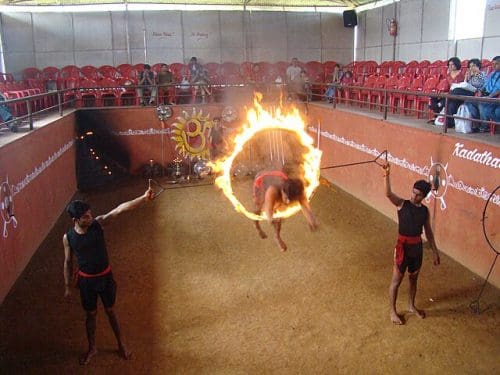
Image Credit: SPat, CC BY-SA 3.0 via Wikimedia Commons
Popular Tournaments and Events:
- Kalaripayattu Championships: Organized at district, state, and national levels, these championships are significant events in the calendar. They are often supported by local and state governments, alongside cultural organizations.
- Cultural Festivals: Many cultural festivals in the state and other parts of India, like the Onam festival or village temple festivals, have demonstrations as part of their celebrations.
- International Kalaripayattu Festival: This event brings together practitioners from all over the world for demonstrations, workshops, and knowledge-sharing sessions. It promotes martial art on a global stage and fosters cross-cultural exchanges.
- University and College Competitions: As part of promoting traditional arts, some universities and colleges in the state include this martial art in their annual sports and cultural competitions.
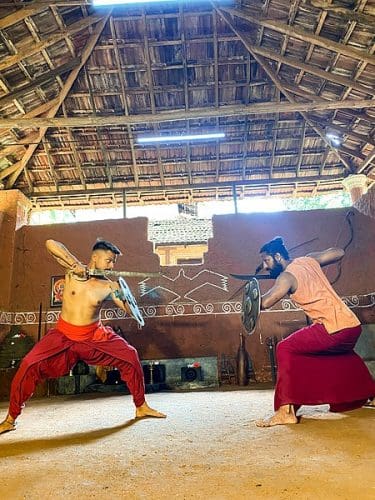
Image Credit: Hazo Hazri, CC BY-SA 4.0 via Wikimedia Commons
Kalaripayattu is much more than just a martial art. It is a philosophy, a way of life, and an embodiment of the cultural and spiritual heritage of Kerala. It instills discipline, respect, and a deep understanding of the human body and mind in its practitioners.
Read More: Latest



